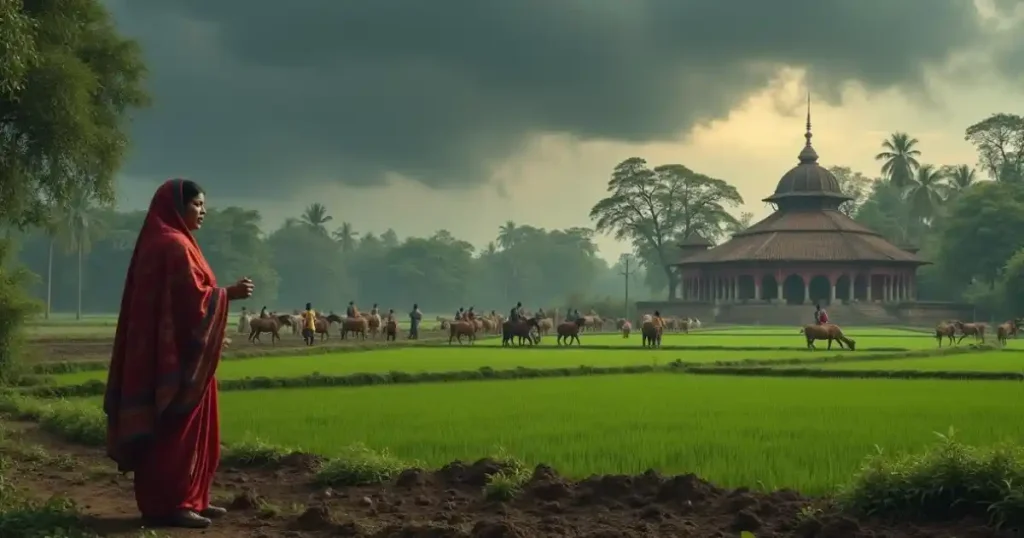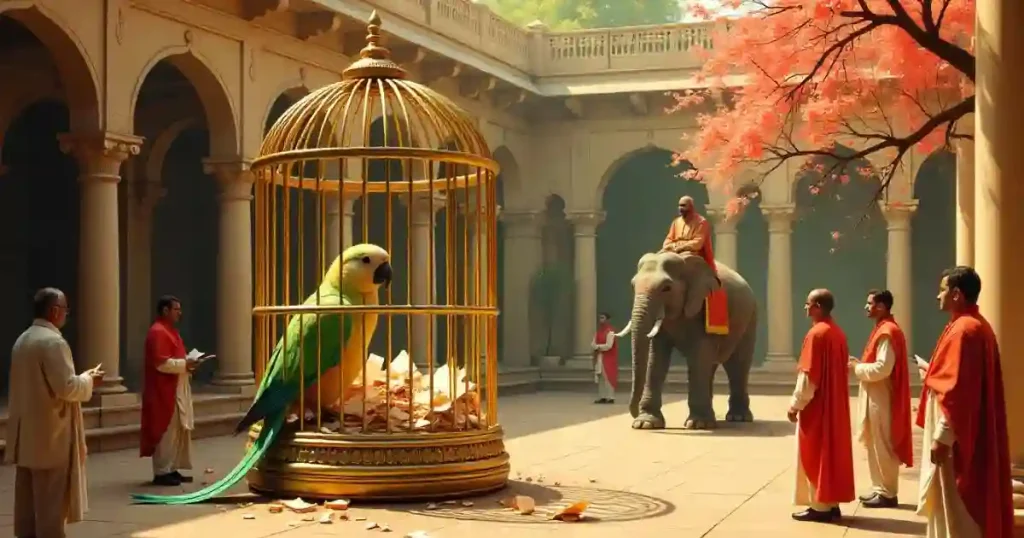Art is more than just a visual creation—it is the soul’s voice, a mirror to society, and a journey of expression. From the delicate motifs of Nakshikantha and Alpana to the bold strokes of modern masterpieces, Bangladeshi art tells the story of its people, their struggles, and triumphs.
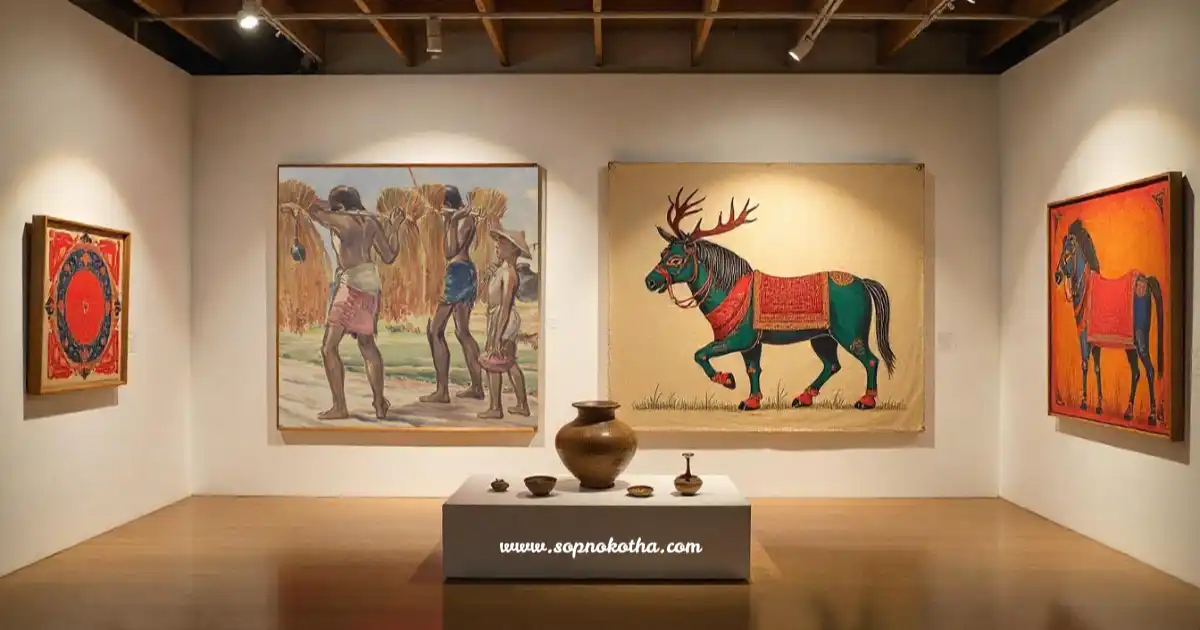
Read more – Folk Music: Powerful and Timeless message of Lalon Shah U2L2
Rooted in both tradition and innovation, our art continues to evolve, inspire, and provoke thought. This article takes you through the inspiring transformation of Bangladeshi art—highlighting 7 defining moments that shaped its powerful legacy.
Art – Important Words & Bangla Meanings
| Word/Phrase | বাংলা অর্থ |
| Expression | প্রকাশ |
| Imagination | কল্পনা |
| Aesthetic | নান্দনিক |
| Social commentary | সামাজিক বিশ্লেষণ বা মন্তব্য |
| Anguish | যন্ত্রণা / কষ্ট |
| Evoke | উদ্রেক করা |
| Souls | আত্মা |
| Creative skills | সৃজনশীল দক্ষতা |
| Glorify | মহিমান্বিত করা / প্রশংসা করা |
| Ravaged | ধ্বংসপ্রাপ্ত / বিপর্যস্ত |
| Appreciation | প্রশংসা / উপলব্ধি |
| Profound | গভীর / তীব্র |
| Adequate | যথেষ্ট / যথাযথ |
| Reject | প্রত্যাখ্যান করা |
| Traditional | ঐতিহ্যবাহী |
| Techniques | কৌশল |
| Styles | রীতি / ধরন |
| Communication | যোগাযোগ |
| Education | শিক্ষা |
| Industrial Revolution | শিল্পবিপ্লব |
| Folk art | লোকশিল্প |
| Pottery | মাটির তৈজসপত্র / হাঁড়ি |
| Embroidered quilt | নকশিকাঁথা |
| Alpana | আলপনা / চালতার মণ্ডের নকশা |
| Painted earthen pots | রঙ করা মাটির হাঁড়ি |
| Abstract expressionism | বিমূর্ত ভাবপ্রকাশমূলক শিল্প |
| From scratch | একেবারে শুরু থেকে |
| Installation art | স্থানভিত্তিক শিল্প / প্রদর্শনী-নির্ভর শিল্প |
| Graphic art | গ্রাফিক চিত্রকলা |
| Contemporary | সমসাময়িক |
| Retrospective | পূর্ববর্তী কাজের প্রদর্শনী |
| Sculptor | ভাস্কর্যশিল্পী |
| Motif | মোটিফ / অলঙ্করণ / নকশা |
| Artefact | শিল্প বস্তু |
| Depict | চিত্রায়িত করা / প্রকাশ করা |
| Bohemian | প্রচলিত সামাজিক নিয়মে বিশ্বাস না রাখা জীবনধারা |
| Recognition | স্বীকৃতি / পরিচিতি |
| Legacy | উত্তরাধিকার / ঐতিহ্য |
| Philosophy | দার্শনিক চিন্তা |
| Collaborate | সহযোগিতা করা |
| In absentia | অনুপস্থিত অবস্থায় |
Bangla Explanation on Art
Paragraph 1: What is Art?
শিল্প হলো মানুষের কল্পনা ও সৃষ্টিশীলতার এক অভিব্যক্তি, যা চিত্রাঙ্কন, ভাস্কর্য, স্থাপত্যসহ নানা রূপে প্রকাশ পায়। শিল্পের মূল উদ্দেশ্য হলো সৌন্দর্য বা নান্দনিকতা জাগানো। তবে শিল্প কেবল দৃষ্টিনন্দন কিছু তৈরি করেই থেমে থাকে না, এটি সমাজের বাস্তবতা, কষ্ট, সংগ্রাম, অথবা বার্তা বহন করতেও ব্যবহৃত হয়। যেমন: সাগরের ওপরে সূর্যাস্তের একটি চিত্র প্রকৃতির গৌরবকে প্রকাশ করে, অন্যদিকে একটি যুদ্ধবিধ্বস্ত শহরের চিত্র মানুষের যন্ত্রণা ও দুঃখকে প্রকাশ করে। বিখ্যাত চিত্রশিল্পী পাবলো পিকাসো এই প্রসঙ্গে বলেন, “শিল্প আমাদের আত্মার ওপর জমে থাকা দৈনন্দিন জীবনের ধুলো পরিষ্কার করে।” অর্থাৎ, শিল্প মানুষের মন ও আত্মাকে বিশুদ্ধ ও প্রভাবিত করে।
Paragraph 2: Folk Art and Modern Art
বাংলাদেশে শিল্পচর্চার একটি দীর্ঘ ও সমৃদ্ধ ইতিহাস রয়েছে। গ্রামীণ জীবনে বিভিন্ন ধরনের লোকশিল্পের ব্যবহার লক্ষ করা যায়—যেমন, মাটির হাঁড়ি, নকশিকাঁথা, আলপনা, এবং শখের হাঁড়ি। এগুলো হলো প্রাচীনকাল থেকে চলে আসা লোকশিল্প। অপরদিকে, আধুনিক শিল্প এসেছে পশ্চিম ইউরোপে শিল্পবিপ্লবের পর, যখন প্রযুক্তি, শিক্ষা, উৎপাদন ও যোগাযোগ ব্যবস্থার পরিবর্তন ঘটেছে। আধুনিক শিল্প ঐতিহ্যগত শিল্পরীতিকে বাদ দিয়ে নতুন চিন্তা, রং, শৈলী ও উপাদানের মাধ্যমে সময়ের ভাবনা ও মানবচিন্তার গভীর পরিবর্তনকে ফুটিয়ে তোলে।
Paragraph 3: The Rise of Modern Art in Bangladesh
বাংলাদেশে আধুনিক শিল্পের সূচনা ঘটে ১৯৪৮ সালে, যখন শিল্পাচার্য জয়নুল আবেদিন এবং তার সহকর্মীরা ঢাকায় একটি আর্ট ইনস্টিটিউট (বর্তমানে ঢাকা বিশ্ববিদ্যালয়ের চারুকলা অনুষদ) প্রতিষ্ঠা করেন। এই ইনস্টিটিউট শিল্প শিক্ষা প্রদান শুরু করে এবং ধীরে ধীরে একদল প্রতিভাবান শিক্ষক ও ছাত্রকে একত্রিত করে, যারা শূন্য থেকে শুরু করে আধুনিক শিল্পচর্চার ভিত্তি গড়ে তোলে। এক দশকের মধ্যেই বাংলাদেশের শিল্পীরা সমকালীন বৈশ্বিক শিল্পধারার প্রভাব—যেমন, এক্সপ্রেশনিজম এবং অ্যাবস্ট্রাক্ট এক্সপ্রেশনিজম—আত্মস্থ করে নিজেদের শিল্পকর্মে উপস্থাপন করেন। তবে তারা লোকশিল্পের ঐতিহ্যের সাথেও ঘনিষ্ঠ সম্পর্ক বজায় রাখেন।
Paragraph 4: Zainul Abedin and His Contribution
শিল্পাচার্য জয়নুল আবেদিন ১৯৪৩ সালের ভয়াবহ দুর্ভিক্ষের উপর ভিত্তি করে যে ‘Famine Sketches’ তৈরি করেন, তা তাকে সর্বভারতীয় খ্যাতি এনে দেয়। এই স্কেচগুলো দুর্ভিক্ষের করুণ বাস্তবতাকে তুলে ধরে দর্শকদের হৃদয়ে নাড়া দেয়। তার জলরং চিত্র, স্ক্রল পেইন্টিং এবং অঙ্কন আজও আমাদের শিল্পীদের জন্য অনুপ্রেরণা হয়ে আছে। তার পাশাপাশি আরও যেসব শিল্পীরা বাংলাদেশের আধুনিক শিল্পকে সমৃদ্ধ করেছেন তাদের মধ্যে উল্লেখযোগ্য নামগুলো হলো: কামরুল হাসান, এস এম সুলতান, সফিউদ্দিন আহমেদ, আব্দুর রাজ্জাক, কাইয়ুম চৌধুরী, মুর্তজা বশির, আমিনুল ইসলাম, সৈয়দ জাহাঙ্গীর, দেবদাস চক্রবর্তী, নভেরা আহমেদ এবং মোহাম্মদ কিবরিয়া।
Paragraph 5: Post-Liberation Art in Bangladesh
১৯৭১ সালের মুক্তিযুদ্ধ ও দেশের স্বাধীনতা আমাদের শিল্পীদের ভিন্ন মাত্রায় অনুপ্রাণিত করে। পূর্ববর্তী শিল্পীদের পদাঙ্ক অনুসরণ করে নতুন প্রজন্মের শিল্পীরা শিল্পের সীমা অতিক্রম করে নতুন অভিব্যক্তির ধারা তৈরি করেন। এরপরের চার দশকে বাংলাদেশে শিল্পে নানা রকম পরীক্ষা-নিরীক্ষা চালানো হয়। শিল্পীরা ইনস্টলেশন আর্ট, গ্রাফিক আর্টসহ নানান নতুন ধারার সঙ্গে কাজ করেন এবং ঐতিহ্যবাহী ধারাগুলোকেও নতুনভাবে উপস্থাপন করেন। আজ যে কোনো আর্ট গ্যালারি বা প্রদর্শনীতে গেলে দেখা যায় কিভাবে শিল্প আমাদের পরিবর্তনশীল বাস্তবতাকে নান্দনিক ও অন্তর্দৃষ্টিপূর্ণভাবে উপস্থাপন করে।
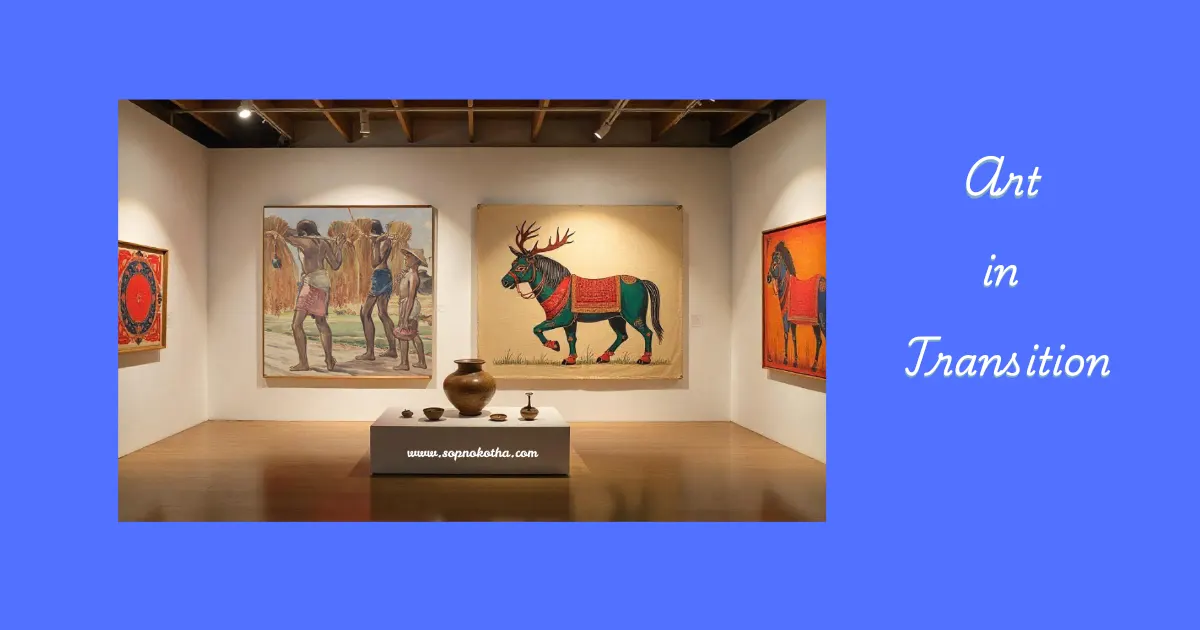
Read more – Right Form of Verbs: 21 Most Powerful Rules to Master Verbs
Art
Art is generally understood as an expression of human imagination and creative skills in a range of activities including painting, drawing, sculpture and architecture. The aim of art is to evoke feelings and emotions that are considered aesthetic – that is, concerned with beauty- but art also can be a form of social commentary.
A painting of sunset over the sea glorifies nature, but one that shows a war ravaged town can convey a sense of anguish. Throughout the world people appreciate art for its power to affect them in creative ways. As the famous painter Pablo Picasso said. “the purpose of art is washing the dust of daily life off our souls.”
Art in our country has a long history. It has been practiced in households in the form of pottery, nakshikantha or embroidered quilt, alpana or intricate, mostly floral designs in rice paste done on clay yards and shokher harhi or painted earthen pots (and their lids). These are examples of folk art. But there is another form of art which is called modern art, which owes its origin to the industrial revolution in Western Europe in the middle of-19 century and the changes it brought in technology, education, manufacturing and communication.
Modern art rejected traditional art forms and began to create new types of artistic expression using styles, techniques, colours and materials that could adequately reflect the spirit of the time and the profound changes in human thought.
The beginning of modern art practices in our country date from 1948, when the great artist Zainul Abedin (1914-1976), with the help of some colleagues set up an institute of art in Dhaka (now the Faculty of Fine Art, University of Dhaka). As it began to offer art education, the institute drew together a number of talented teachers and students who contributed to the development of modern art almost from scratch.
But within a decade, artists were reflecting most recent trends and styles in their work – such as expressionism and abstract expressionism- while maintaining a close contact with the traditions of folk art.
Zainul had earned all-India fame for his Famine Sketches, a series of haunting sketches based on the Bengal famine of 1943 which took hundreds of thousands of lives. His watercolors, scroll paintings and drawings inspire our artists even today. The other prominent artists who had major contributions to the spectacular rise of our contemporary art include Qamrul Hassan, SM Sultan, Safiuddin Ahmed, Abdur Razzak, Qayyum Chowdhury, Murtaza Bascer, Aminul Islam. Syed Jahangir, Debdas Chakravarty, Novera Ahmed and Muhammad Kibria.
The war of liberation and the independence of the country in 1971 inspired our artists to continue the efforts of the earlier artists to explore the limits of art and create new expressive modes. For the next four decades, art in our country saw many experimentations. Artists dealt with new ideas such as installation art and graphic art. and reshaped older, traditional art forms. If you visit any art gallery or art exhibition, you will find how our art reflects our changing realities in fascinating and insightful ways.
[This passage/content is taken from the National Curriculum and Textbook Board (NCTB), Bangladesh English textbook for educational purposes only.]
© NCTB Bangladesh. All rights reserved to the original publisher.
Historical Events (For Art and Zainul Abedin Passage)
| Historical Event | Brief Explanation (Bangla) |
| Industrial Revolution (১৮০০-এর দশক) | পশ্চিম ইউরোপে শুরু হওয়া এক প্রযুক্তিগত ও সামাজিক বিপ্লব, যা শিল্প, শিক্ষা, উৎপাদন ও যোগাযোগ ব্যবস্থায় ব্যাপক পরিবর্তন আনে। এর প্রভাবে আধুনিক শিল্পের বিকাশ ঘটে। |
| Bengal Famine of 1943 (বেঙ্গল দুর্ভিক্ষ) | ১৯৪৩ সালে বাংলা অঞ্চলে ভয়াবহ দুর্ভিক্ষে লক্ষ লক্ষ মানুষ মারা যান। জয়নুল আবেদিন এই দুর্ভিক্ষের করুণ বাস্তবতা তার ‘Famine Sketches’ দিয়ে ফুটিয়ে তোলেন। |
| Establishment of the Dhaka Art Institute (১৯৪৮) | ঢাকায় শিল্প শিক্ষা প্রতিষ্ঠানের সূচনা, যা পরবর্তীতে ঢাকা বিশ্ববিদ্যালয়ের চারুকলা অনুষদ হিসেবে গড়ে ওঠে। এটি আধুনিক শিল্পচর্চার কেন্দ্রবিন্দু হয়। |
| Bangladesh Liberation War (১৯৭১) | ১৯৭১ সালে বাংলাদেশের মুক্তিযুদ্ধ, যা দেশের স্বাধীনতা এনে দেয় এবং শিল্পী সমাজকে নতুন করে অনুপ্রাণিত করে নতুন শিল্পধারার সৃষ্টি করে। |
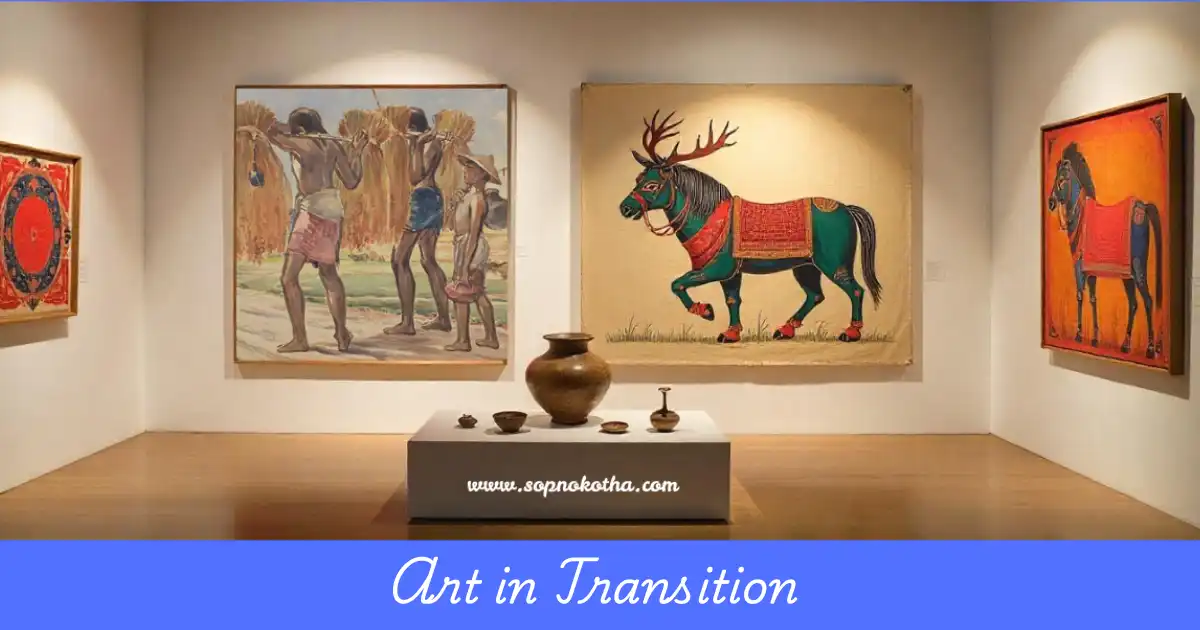
Read more – Zainul Abedin – 11 artworks – painting
Literary Terms (For Art and Zainul Abedin Passage)
| Term | Explanation (Bangla) | Example/Context in Passage |
| Expressionism | শিল্পধারা যেখানে শিল্পী আবেগ ও মানসিক অবস্থা প্রকাশের ওপর গুরুত্ব দেন, রূপ ও রং দিয়ে অনুভূতি ফুটিয়ে তোলা হয়। | আধুনিক শিল্পের মধ্যে এক্সপ্রেশনিজম শিল্পীরা মানুষের ভিতরের আবেগ প্রকাশ করেন। |
| Abstract Expressionism | শিল্পধারা যা বাস্তব থেকে দূরে থেকে রং, রেখা ও আকার দিয়ে অনুভূতি ও ভাব প্রকাশ করে, নির্দিষ্ট কোনো ছবি বা বিষয় প্রকাশ না করে। | আধুনিক শিল্পে এই ধারার প্রভাব লক্ষ করা যায়। |
| Folk Art (লোকশিল্প) | সাধারণ মানুষের তৈরি ঐতিহ্যবাহী শিল্প, যা সমাজ ও সংস্কৃতির অংশ হিসেবে চলে আসে, সাধারণত গ্রামীণ জীবন ও সংস্কৃতির প্রতিফলন। | নকশিকাঁথা, আলপনা, মাটির হাঁড়ি ইত্যাদি লোকশিল্পের উদাহরণ। |
| Social Commentary | সমাজের সমস্যা বা বাস্তবতা শিল্পের মাধ্যমে প্রকাশের একটি রূপ। | যুদ্ধবিধ্বস্ত শহরের চিত্র মানব যন্ত্রণা প্রকাশের মাধ্যমে সমাজের অবস্থা তুলে ধরে। |
| Metaphor (রূপক) | সরাসরি না বলে অন্য কিছু দ্বারা কোনো বিষয় বা ভাব প্রকাশ। | “শিল্প আমাদের আত্মার ওপর জমে থাকা ধুলো পরিষ্কার করে” — শিল্পকে আত্মার ধুলোর রূপকে বলা হয়েছে। |
| Haunting | এমন কিছু যা দীর্ঘদিন স্মৃতিতে থেকে যায় ও ভাবনায় প্রভাব ফেলে। | জয়নুল আবেদিনের দুর্ভিক্ষ স্কেচগুলো ‘haunting’ অর্থাৎ মনে গভীর ছাপ ফেলে। |
| Retrospective Exhibition | এক শিল্পীর পূর্ববর্তী কাজসমূহের সমন্বয়ে গঠিত প্রদর্শনী। | গ্যোথে ইনস্টিটিউটের ১৯৮৭ সালের প্রদর্শনী ছিল জয়নুল আবেদিনের রেট্রোস্পেকটিভ। |
10 short questions based on the passage on Art:
- What is art generally understood as?
- What is the main aim of art?
- How can art be a form of social commentary?
- What does Picasso say about the purpose of art?
- What are some examples of folk art in our country?
- When did modern art begin in our country?
- Who is considered the pioneer of modern art in Bangladesh?
- What are Zainul Abedin’s Famine Sketches based on?
- Name three other prominent artists of our country.
- How did the Liberation War of 1971 influence our art?
